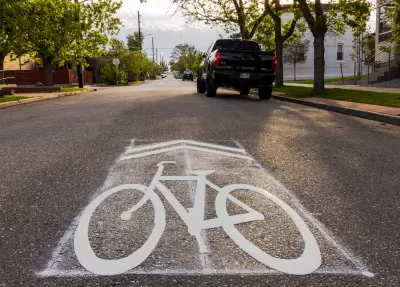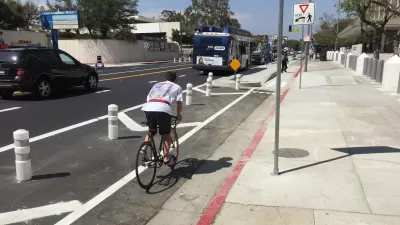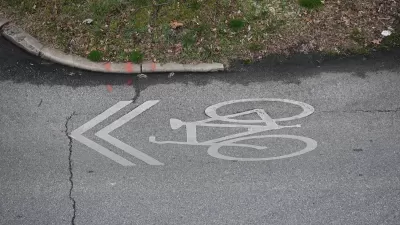The painted symbols can not only fail to protect bike riders, but can actually make riding conditions less safe.

An article written by Momentum Magazine staff argues that sharrows, once believed to be an effective way to remind drivers to share the road with bikes, are at best ineffective and at worst downright dangerous.
If you’re unfamiliar with these sad, lonely symbols, they’re those little bike-shaped icons painted onto roads that are supposed to indicate where cyclists should ride. But in reality, they’re about as effective as trying to protect yourself from a charging rhino with a wet paper towel.
According to the article, “Studies have shown that sharrows don’t actually provide any real safety benefits for cyclists. In fact, they may even make things worse by encouraging drivers to pass cyclists too closely.” Planetizen previously covered this shift in mindset, when People For Bikes senior director Dave Snyder admitted in an opinion piece that he “was wrong” when he enthusiastically supported sharrows decades ago.
“Time and time again, research demonstrates that sharrows are ineffective at improving cyclist safety.” In fact, “We know now that even actual bike lanes painted in some eye-catching hue do not provide enough safety for cyclists.” In the worst cases sharrows can engender a “false sense of security” and encourage drivers to pass too closely and cyclists to ride too close to parked cars.
As bike advocates regularly explain, “The best bicycle infrastructure for safe cycling is dedicated bike lanes that provide physical separation between cyclists and vehicles,” which can reduce the risk of injury for cyclists by as much as 90 percent, according to one study. Bike lanes are also shown to boost sales for local businesses, and naturally reduce carbon emissions when replacing car trips. As Snyder and other advocates argue, cities should invest in bike infrastructure that truly protects bike riders, other street users, and the environment.
FULL STORY: Sharrows used to make sense in theory, but are now useless and possibly dangerous in practice

Planetizen Federal Action Tracker
A weekly monitor of how Trump’s orders and actions are impacting planners and planning in America.

Congressman Proposes Bill to Rename DC Metro “Trump Train”
The Make Autorail Great Again Act would withhold federal funding to the system until the Washington Metropolitan Area Transit Authority (WMATA), rebrands as the Washington Metropolitan Authority for Greater Access (WMAGA).

The Simple Legislative Tool Transforming Vacant Downtowns
In California, Michigan and Georgia, an easy win is bringing dollars — and delight — back to city centers.

The States Losing Rural Delivery Rooms at an Alarming Pace
In some states, as few as 9% of rural hospitals still deliver babies. As a result, rising pre-term births, no adequate pre-term care and "harrowing" close calls are a growing reality.

The Small South Asian Republic Going all in on EVs
Thanks to one simple policy change less than five years ago, 65% of new cars in this Himalayan country are now electric.

DC Backpedals on Bike Lane Protection, Swaps Barriers for Paint
Citing aesthetic concerns, the city is removing the concrete barriers and flexposts that once separated Arizona Avenue cyclists from motor vehicles.
Urban Design for Planners 1: Software Tools
This six-course series explores essential urban design concepts using open source software and equips planners with the tools they need to participate fully in the urban design process.
Planning for Universal Design
Learn the tools for implementing Universal Design in planning regulations.
Smith Gee Studio
City of Charlotte
City of Camden Redevelopment Agency
City of Astoria
Transportation Research & Education Center (TREC) at Portland State University
US High Speed Rail Association
City of Camden Redevelopment Agency
Municipality of Princeton (NJ)





























